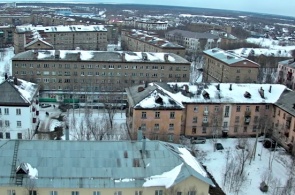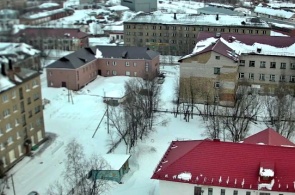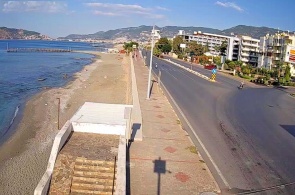INTA– one of the cities of the Komi Republic, located in the far North. The winters are harsh, snow drifts knee-deep, and the wind is quite virtuosic. The city was founded already in the twentieth century, therefore, will not find here the old attractions. The main attribute in INTA is a Water tower. This building serves as a symbol of the city emblem, also has a history. It is associated with the photos, hidden in a tower spire of a certain Swede, interior decorator and part-time prisoner, who was styled "King Arthur" for the stately Royal posture. A story in the style of Monte Cristo, it will be interesting to see the travelers.Water towerbuilt in the Gothic style, its height is 38 m, and the builders were none other, as Minlake political prisoners and the Gulag. The number of workers exceeded 10 thousand people. Except the tower, prisoners were engaged in construction of coal mines, one of which still operates. In the tower, which has long served its main purpose, which is now a branch Museum of local Lore. On the first floor you can see the original panoramic image of a fuchuan. On the second floor it is not possible to get, but to enable people in absentia to see the main composite of the exposure – mounted monitors, which broadcast the barracks with preserved the life of prisoners, and many other images that provide historical value. Not far from the tower also came alley "Faith, hope, love", well beautiful curved benches with elements of artistic forging, depicting the main symbol of the city. Here I like to walk couples, to newlyweds photo shoot. Interesting sites are the so-called "towers". The wooden houses preserved to our days. They stand under the open sky, on city streets, and have a peculiar appearance. Street in. wide, though the population is small. Some houses are built of yellow brick and still intact, others considerably decayed, but trying bravely to withstand the local climate. On the facades of buildings found in many large brick patterns, on the streets grow whole Avenue of white birches. Despite the small number living in the city people built a huge area for folk festivals. The main one isLenin squarelocated at the walls of the city hall and post office. On the second largest square, which is called "Komsomol" towering monument to soldiers who died in the great Patriotic war.
More details
The Inta webcam offers a view of the streets from the top of the water tower, which is considered a local landmark and a symbol of the city. The lens covers Polyarnaya Street and adjoining houses. The broadcast is transmitted in real time.
INTA, Russia
09.04.23
Inta webcam is installed on the water tower and shows a view of the central area. The lens is directed towards the street. Peace. In the foreground, the view is opened by the House of Pioneers, behind which school No. 5 is located. The broadcast is transmitted in real time.
INTA, Russia
08.04.23
INTA, a city of Republican subordination of the Komi Republic. Located on the North-East of the Republic.-D. station on the line Moscow-Vorkuta.
INTA, Russia
10.10.17
The city name comes from Komi-Nenets word "INTA", which translated means the place where a lot of water. The history of the city and region goes back to antiquity. Close to INTA, in the town of Adak geologists discovered prehistoric man.
INTA, Russia
10.04.17
INTA is a town on the North of the Komi Republic, a city whose economy is concentrated on mining of thermal coal. Located in the area North of the railway line, in 1999, km from Moscow.
INTA, Russia
10.04.17
The camera covers the views of the residential quarter of the city of INTA, in the Komi Republic. The district is called "Mining town". There are 5-storey and 9-storey buildings. This is the Central part of the city, which, in the mid-twentieth century and began its development.
INTA, Russia
14.03.16
View facing Gorky street in INTA, Komi Republic. The web camera is located on Lenin square. The overview covers the building of the Central post office and savings Bank. Nearby is the heritage Centre, children's library, scientific research institutes, several supermarkets, as well as the monuments to Lenin and the Emblem of INTA.
INTA, Russia
14.03.16
View the Lenin square in the town of INTA, located in the North of the Komi Republic (Russia). The camera is attached on the building of the post office. The overview covers the square with the monument to the Leader, as well as the city administration building. This area is full of shops, supermarkets, food service establishments.
INTA, Russia
14.03.16
popular camerasshow all
Stavanger, a town in the commune of Norway, located in the South-Western part of the country, on the Peninsula, rich in minerals. Tanager combines the influence of foreign organisations such as NATO and oil companies. The camera will shoot the harbour and the promenade of the city.
Stavanger, Norway
Sultanahmet or Blue mosque is a work of art of Turkish-Islamic architecture. Its construction began in 1609, the construction work took seven years to a 19-year-old Sultan. The name of the mosque was, due to its interesting and unique finish.
Istanbul, Turkey
A webcam broadcasts the district of Tosmur - quiet location in the Eastern part of Alanya, located only five kilometres from the city centre. Its rural way of life and the beauty of untouched nature attract tourists.
Alanya, Turkey
Shark Island or in English of Shark island, located in the harbour city of Sydney, the suburb of Point Piper. The locals, the natives named the island Boambilly, which translated means Shark island. After all, this name is not casual, because it's mean and looks like a shark fin.
Sydney, Australia
The webcam is installed on site Alva. Tsaghkadzor ski resort town in Armenia. Tsaghkadzor is a beautiful mountainous area among deciduous forests, with a pleasant winter climate, and clean fresh air. The highest point is 1800 meters. The truss type is a classic, divided into three.
Tsakhkadzor, Armenia
















